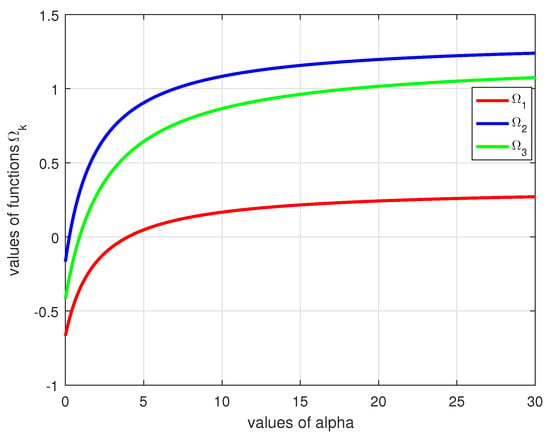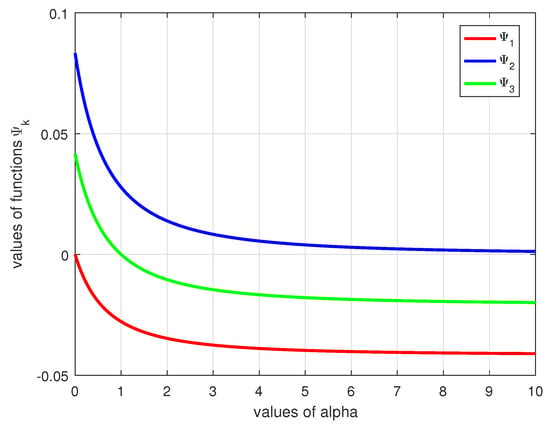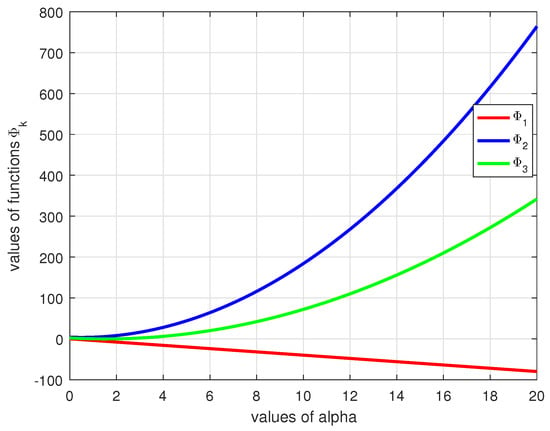Abstract
Simpson’s rule is a numerical method used for approximating the definite integral of a function. In this paper, by utilizing mappings whose second derivatives are bounded, we acquire the upper and lower bounds for the Simpson-type inequalities by means of Riemann–Liouville fractional integral operators. We also study special cases of our main results. Furthermore, we give some examples with graphs to illustrate the main results. This study on fractional Simpson’s inequalities is the first paper in the literature as a method.
MSC:
26D07; 26D10
1. Introduction
The classical Simpson’s inequality for four times continuously differentiable functions is the following.
Theorem 1
([1]). Let be a four times continuously differentiable function on , and let us consider Then, the following inequality holds:
Since the theory of convex functions is an effective and useful way to solve a large number of problems from different branches of mathematics, many mathematicians have investigated the Simpson-type inequalities for convex functions. More precisely, in [1], some Simpson-type inequalities via s-convex mappings are established by utilizing differentiable mappings. Furthermore, new versions of the Simpson-type inequalities for differentiable convex mappings were established in [2,3]. The reader is referred to [4,5,6,7,8,9,10] and the references therein for more information and unexplained aspects regarding Simpson-type inequalities for various convex classes.
Many mathematicians have investigated the twice differentiable convex functions to obtain significant inequalities. For example, Sarikaya et al. proved some inequalities of Simpson’s type by using twice differentiable mappings in [11]. In addition, some Simpson-type inequalities are given for differentiable convex mappings in [12]. Moreover, the authors provide new estimates on the generalization of Hadamard, Ostrowski, and Simpson inequalities in the case of functions whose second derivatives in absolute values at certain powers are convex and quasi-convex functions in [13]. Furthermore, Simpson-type inequalities are established for convex functions in [14]. The reader may refer to [15,16,17,18] for further pieces of information and unexplained aspects regarding these types of inequalities, including twice differentiable functions.
Mathematical preliminaries in fractional calculus theory, which will be used throughout this paper, are given as follows.
Definition 1
([19]). Let us consider The Riemann–Liouville integrals and of order are defined by
and
respectively. Here, is the Gamma function and is described as follows:
Let us also note that
Remark 1.
If we choose in Definition 1, then the fractional integral reduces to the classical integral.
In [20], the Simpson inequalities for differentiable functions are extended to Riemann–Liouville fractional integrals. In addition to these, several papers are focused on fractional Simpson inequalities [21,22,23,24,25,26,27]. For further similar results and properties of Riemann–Liouville fractional integrals, see [19,28,29,30,31].
In [32], the authors proved some new inequalities of Simpson’s type based on convexity by fractional integrals. If we choose as in ([32], Theorem 2.3), we obtain the following.
Theorem 2
([32]). Let be a function such that f is differentiable on . Let with Suppose that and is convex on Then, the following inequality for Riemann–Liouville fractional integrals holds:
Here,
Theorem 3
([33]). Suppose that the assumptions of Theorem 2 hold. Then, the following inequalities hold:
where
Iqbal et al. [20] established new Simpson-type inequalities for Riemann–Liouville fractional integrals using the convexity for the class of functions whose derivatives in absolute value at certain powers are convex functions, as proposed in the following theorem.
Theorem 4
([20]). Suppose that the assumptions of Theorem 2 are valid. Then, the inequality
is valid. Here, and
The purpose of this paper is to prove some Simpson-type inequalities for Riemann–Liouville fractional integrals. The general structure of the paper consists of three sections, including the Introduction. The remaining parts of the paper are as follows. In Section 2, we will establish some upper and lower bounds for Simpson’s rule for Riemann–Liouville fractional integral operators by using functions whose second derivatives are bounded. Moreover, we also show a Simpson-type inequality for Riemann integrals by using a special case of our main results. Furthermore, we will give some examples to illustrate the main results. In the last section, some conclusions and further directions of research will be presented.
2. Main Results of Simpson-Type Inequalities for Bounded Functions
In this section, we establish the following inequalities, which give the upper and lower bounds for the Simpson-type inequalities for Riemann–Liouville fractional integral operators. Here, fractional Simpson-type inequalities are applied to the functions that have the conditions for all instead of convexity. Throughout this paper, we will refer to Theorems 2–4 as the Simpson-type inequalities of the first sense, second sense, and third sense, respectively.
2.1. Simpson-Type Inequalities of the First Sense
Theorem 5.
Let be a positive, twice differentiable function, and If is bounded, i.e., for all with and then the following inequalities hold:
Proof.
By using the change of variables, we have
By the equality (2), we obtain
We can write easily that
and
We also have
With the help of the equality (8), it follows that
By using the equality (9), it follows that
Multiplying the inequalities (14) by and integrating the resultant inequality with respect to x on , we have
This completes the proof of Theorem 5. □
Corollary 1.
Let us consider in Theorem 5. Then, we obtain
Equivalently, we have
Example 1.

If we define a function by , then we obtain and . Let us consider the left and right sides of the inequalities (1) as follows:
and
As one can see in Figure 1, the result of our appropriate choices in Example 1 is provided in the double inequality (1).

Figure 1.
Graph for the result of Example 1 computed and plotted in MATLAB program.
2.2. Simpson’s Type Inequalities of the Second Sense
Theorem 6.
Under the assumptions of Theorem 5, we have the following double inequality:
Proof.
By using the change of variables, we have
By the equalities (19), we obtain
Multiplying the inequality (14) by and integrating the resultant inequality with respect to x on , we obtain
If we consider the equalities
and
then we obtain
This concludes the proof of the inequalities (18). □
Remark 2.
If we choose in Theorem 6, then Theorem 6 reduces to Corollary 1.
Example 2.

If we describe a function by , then we have and . The left and right sides of the inequalities (18) are as follows:
and

Figure 2.
A graph computed and drawn in MATLAB program for the result of Example 2.
2.3. Simpson’s Type Inequalities of the Third Sense
Theorem 7.
Under the assumptions of Theorem 5, we have the inequalities
Proof.
With the help of the change of variables, we have
By the equality (24), we obtain
Multiplying the inequalities (14) by and integrating the resultant inequality with respect to x on , it follows that
This completes the proof of Theorem 7. □
Remark 3.
Let us consider in Theorem 7. Then, Theorem 7 becomes Corollary 1.
Example 3.

If we choose a function by then we obtain and . Let us consider the left and right sides of the double inequality (23). Then, the following equalities hold:
and
Similarly, we can also obtain
As one can see in Figure 3, the result of our appropriate choices in Example 3 is provided in the double inequality (23).

Figure 3.
Graph for the result of Example 3, calculated and plotted in MATLAB program.
3. Conclusions
In the present paper, we prove some Simpson-type inequalities for Riemann–Liouville fractional integral operators by utilizing the functions whose second derivatives are bounded. Some examples that give a graphical illustration of our main results are presented. With reference to our paper, other authors can try to find better bounds using functions with conditions for all instead of convexity in future studies. Moreover, by applying these results, researchers can obtain some new approaches in the theory of optimization.
Author Contributions
H.B.: problem statement, investigation, methodology, supervision, writing—review and editing. F.H.: computation, conceptualization, investigation, writing—original draft. H.K.: computation, investigation, writing—original draft. M.Z.S.: problem statement, investigation, methodology, supervision. All authors have read and agreed to the published version of the manuscript.
Funding
This research received no external funding.
Data Availability Statement
Data sharing not applicable to this paper as no data sets were generated or analyzed during the current study.
Acknowledgments
The authors would like to express their sincere thanks to the editor and the anonymous reviewers for their helpful comments and suggestions.
Conflicts of Interest
There is no conflict of interest declared by the authors.
References
- Alomari, M.; Darus, M.; Dragomir, S.S. New inequalities of Simpson’s type for s-convex functions with applications. RGMIA Res. Rep. Coll. 2009, 12. [Google Scholar]
- Sarikaya, M.Z.; Set, E.; Özdemir, M.E. On new inequalities of Simpson’s type for convex functions. RGMIA Res. Rep. Coll. 2010, 13, 2. [Google Scholar] [CrossRef]
- Sarikaya, M.Z.; Set, E.; Özdemir, M.E. On new inequalities of Simpson’s type for s-convex functions. Comput. Math. Appl. 2020, 60, 2191–2199. [Google Scholar] [CrossRef]
- Du, T.; Li, Y.; Yang, Z. A generalization of Simpson’s inequality via differentiable mapping using extended (s,m)-convex functions. Appl. Math. Comput. 2017, 293, 358–369. [Google Scholar] [CrossRef]
- İşcan, İ. Hermite-Hadamard and Simpson-like type inequalities for differentiable harmonically convex functions. J. Math. 2014, 2014, 346305. [Google Scholar] [CrossRef]
- Li, Y.; Du, T. Some Simpson type integral inequalities for functions whose third derivatives are (α,m)-GA-convex functions. J. Egypt. Math. 2016, 24, 175–180. [Google Scholar] [CrossRef]
- Liu, W. Some Simpson type inequalities for h-convex and (α,m)-convex functions. J. Comput. Anal. App. 2014, 16, 1005–1012. [Google Scholar]
- Ozdemir, M.E.; Akdemir, A.O.; Kavurmacı, H. On the Simpson’s inequality for convex functions on the coordinates. Turk. Anal. Number Theory 2014, 2, 165–169. [Google Scholar] [CrossRef]
- Park, J. On Simpson-like type integral inequalities for differentiable preinvex functions. Appl. Math. Sci. 2013, 7, 6009–6021. [Google Scholar] [CrossRef]
- Matloka, M. Some inequalities of Simpson type for h-convex functions via fractional integrals. Abstr. Appl. Anal. 2015, 2015, 956850. [Google Scholar] [CrossRef]
- Sarikaya, M.Z.; Set, E.; Özdemir, M.E. On new inequalities of Simpson’s type for functions whose second derivatives absolute values are convex. J. Appl. Math. Stat. Inform. 2013, 9, 37–45. [Google Scholar] [CrossRef]
- Sarikaya, M.Z.; Aktan, N. On the generalization of some integral inequalities and their applications. Math. Computer Model. 2011, 54, 2175–2182. [Google Scholar] [CrossRef]
- Park, J. On Some Integral Inequalities for Twice Differentiable Quasi–Convex and Convex Functions via Fractional Integrals. Appl. Math. Sci. 2015, 9, 3057–3069. [Google Scholar] [CrossRef]
- Ozdemir, M.E.; Yildiz, C. New inequalities for Hermite-Hadamard and Simpson type with applications. Tamkang J. Math. 2013, 44, 209–216. [Google Scholar] [CrossRef]
- Hezenci, F.; Budak, H.; Kara, H. New version of Fractional Simpson type inequalities for twice differentiable functions. Adv. Differ. Equ. 2021, 2021, 460. [Google Scholar] [CrossRef]
- Hussain, S.; Qisar, S. More results on Simpson’s type inequality through convexity for twice differentiable continuous mappings. SpringerPlus 2016, 5, 77. [Google Scholar] [CrossRef]
- Vivas-Cortez, M.; Abdeljawad, T.; Mohammed, P.O.; Rangel-Oliveros, Y. Simpson’s integral inequalities for twice differentiable convex functions. Math. Probl. Eng. 2020, 2020, 1936461. [Google Scholar] [CrossRef]
- You, X.; Hezenci, F.; Budak, H.; Kara, H. New Simpson type inequalities for twice differentiable functions via generalized fractional integrals. AIMS Math. 2021, 7, 3959–3971. [Google Scholar] [CrossRef]
- Kilbas, A.A.; Srivastava, H.M.; Trujillo, J.J. Theory and Applications of Fractional Differential Equations; Mathematics Studies; Elsevier: Amsterdam, The Netherlands, 2006; Volume 204. [Google Scholar]
- Iqbal, M.; Qaisar, S.; Hussain, S. On Simpson’s type inequalities utilizing fractional integrals. J. Comput. Anal. Appl. 2017, 23, 1137–1145. [Google Scholar]
- Abdeljawad, T.; Rashid, S.; Hammouch, Z.; İşcan, İ.; Chu, Y.M. Some new Simpson-type inequalities for generalized p-convex function on fractal sets with applications. Adv. Differ. 2020, 2020, 496. [Google Scholar] [CrossRef]
- Dragomir, S.S.; Agarwal, R.P.; Cerone, P. On Simpson’s inequality and applications. J. Inequal. Appl. 2000, 5, 533–579. [Google Scholar] [CrossRef]
- Hussain, S.; Khalid, J.; Chu, Y.M. Some generalized fractional integral Simpson’s type inequalities with applications. AIMS Math 2020, 5, 5859–5883. [Google Scholar] [CrossRef]
- Kermausuor, S. Simpson’s type inequalities via the Katugampola fractional integrals for s-convex functions. Kragujev. J. Math. 2021, 45, 709–720. [Google Scholar] [CrossRef]
- Liu, B.Z. An inequality of Simpson type. Proc. R. Soc. A Math. Phys. Eng. Sci. 2005, 461, 2155–2158. [Google Scholar] [CrossRef]
- Lei, H.; Hu, G.; Nie, J.; Du, T. Generalized Simpson-type inequalities considering first derivatives through the k-Fractional Integrals. Iaeng Int. J. Appl. Math. 2020, 50, 1–8. [Google Scholar]
- Rashid, S.; Akdemir, A.O.; Jarad, F.; Noor, M.A.; Noor, K.I. Simpson’s type integral inequalities for κ-fractional integrals and their applications. AIMS Math. 2019, 4, 1087–1100. [Google Scholar] [CrossRef]
- Budak, H.; Hezenci, F.; Kara, H. On parameterized inequalities of Ostrowski and Simpson type for convex functions via generalized fractional integrals. Math. Methods Appl. Sci. 2021, 44, 12522–12536. [Google Scholar] [CrossRef]
- Gorenflo, R.; Mainardi, F. Fractional Calculus: Integral and Differential Equations of Fractional Order; Springer: Vienna, Austria, 1997; pp. 223–276. [Google Scholar]
- Luo, C.; Du, T. Generalized Simpson type inequalities involving Riemann-Liouville fractional integrals and their applications. Filomat 2020, 34, 751–760. [Google Scholar] [CrossRef]
- Miller, S.; Ross, B. An Introduction to the Fractional Calculus and Fractional Differential Equations; Wiley: New York, NY, USA, 1993. [Google Scholar]
- Chen, J.; Huang, X. Some new inequalities of Simpson’s type for s-convex functions via fractional integrals. Filomat 2017, 31, 4989–4997. [Google Scholar] [CrossRef]
- Hai, X.; Wang, S.H. Simpson type inequalities for convex function based on the generalized fractional integrals. Turk. Inequal. 2021, 5, 1–15. [Google Scholar]
Disclaimer/Publisher’s Note: The statements, opinions and data contained in all publications are solely those of the individual author(s) and contributor(s) and not of MDPI and/or the editor(s). MDPI and/or the editor(s) disclaim responsibility for any injury to people or property resulting from any ideas, methods, instructions or products referred to in the content. |
© 2023 by the authors. Licensee MDPI, Basel, Switzerland. This article is an open access article distributed under the terms and conditions of the Creative Commons Attribution (CC BY) license (https://creativecommons.org/licenses/by/4.0/).